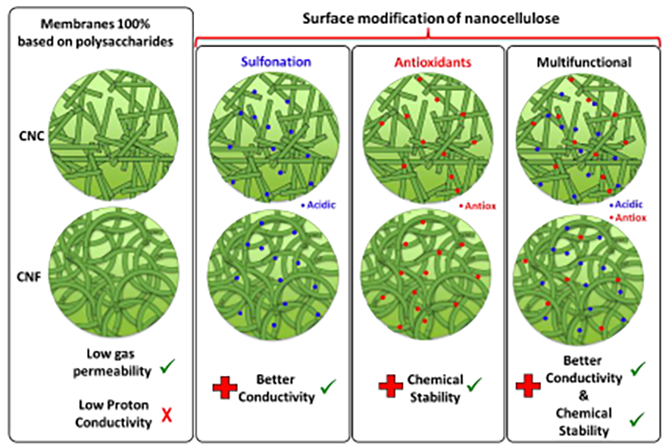
IonMCell (2024-2027)
High performance functionalized cellulose membranes for Fuel Cell
The aim of the IonMcell project (ANR) is to produce proton exchange membranes for fuel cells (PEMFC) based on cellulose materials. The short-term aim is to replace the polyfluoroalkylated substances (PFAS) used in commercial membranes such as Nafion or Aquivion. The project brings together two academic partners: CERMAV and SyMMES, and two technology centres : CTP and FCBA.
Aim of the project
The initial aim of the project is to design a set of bio-sourced membranes by playing on the nature and structure of the polysaccharides and the ability to independently modify their surface chemistry with a variety of active functions. By allowing structural aspects to be decoupled from functionalisation aspects, such model systems will provide a more fundamental understanding of ionic transport in fibrillar membranes as a function of their microstructure, the chemistry of the material and its constituents, and the role of the solvent.In addition, the project aims to clarify their thermomechanical properties with regard to their ageing mechanism by studying the issues of long-term chemical and mechanical stability. With the help of this research into the structure-properties relationship and controlled surface engineering, the aim will be to give polysaccharide-based membranes a high level of ionic conduction. This would represent a major breakthrough in the design of ion exchange membranes.
The development of proton exchange membrane fuel cells, which convert hydrogen into electricity, is an essential part of the energy transition. The advantage of this electrochemical process is that it is non-polluting, generating mainly water.
The IonMcell project aims to combine the expertise of academic laboratories and recognised technical centres in biobased materials (CERMAV, CTP, FCBA) and ion-conducting polymers (SyMMES) to establish cellulose, from an abundant and renewable biomass, in the world of fuel cells by designing inexpensive and durable proton exchange membranes. The aim is to further improve the mechanical and conductivity properties of sPEEK-based (non-fluorinated) membranes using chemically functionalized cellulose nanocrystal (CNC) or nanofibril (MFC) fillers. This functionalization (e.g. periodate oxidation, sulphonation) will increase the content of anionic sites in the matrix to improve the proton conduction properties of the biocomposite.
 source : ANR
source : ANR